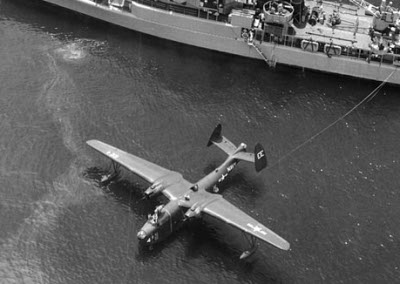![]() The Pacific War Online Encyclopedia
The Pacific War Online Encyclopedia
|
| Previous: PB2Y Coronado, U.S. Flying Boat | Table of Contents | Next: PBY Catalina, U.S. Flying Boat |

National Archives #80-G-483681
Martin PBM-3C Mariner
| Crew | 7 to 8 |
| Dimensions | 118' by 80' by 27'6" 36.0m by 24.4m by 8.4m |
| Wing area | 1408 square feet 130.8 square meters |
| Weight | 32,378-58,000 lbs 14,686-26,000 kg |
| Maximum speed | 198 mph at 13,000 feet 319 km/h at 4000 meters |
| Cruise speed | 135 mph 217 km/h |
| Landing speed | 76 mph 122 km/h |
| Climb rate | 7 feet per second 2.1 meters per second |
| Service ceiling | 16,900 feet 5150 meters |
| Power plant | two 1700 hp (1268 kW) R-2600-12 Wright Cyclone 14-cylinder two-row radial engines driving four bladed propellers |
| Armament | 1 twin 0.50
dorsal turret 1 twin 0.50 nose turret 2 0.50 machine guns in waists 2 0.50 machine guns in tail |
| External stores | 2000 lbs (910 kg) of bombs or depth charges |
| Range | 2137 miles 3439 km |
| Fuel | 1950-2744 gallons |
| Sensors |
ASG surface search radar |
| Production | 1405 of all types at
The Glenn L. Martin Company, Baltimore, MD: 1 XPBM-1 20 PBM-1 1 XPBM-2 32 PBM-3B/GR.I 274 PBM-3C 201 PBM-3D 50 PBM-3R 156 PBM-3S 2 XPBM-5 631 PBM-5 1 XPBM-5A 36 PBM-5A |
| Variants |
The -3D could carry up to 8000 lbs of ordinance, including two underwing torpedoes. The -3R was a transport version. The -3S was an antisubmarine version. The -5 had an APS-15 radar and 2100 hp (1566 kW) R-2800-34 engines. The -5A was an amphibious version of the -5 |
The Martin Mariner was the successor
to the Catalina, and
was somewhat
overshadowed by its famous predecessor. It was an excellent
patrol aircraft
that continued in production after the war, but, like most modern
aircraft,
required much from the pilots
and crew. The Mariner was very
stable, but had
high wing and power loadings. It was capable of carrying a
very heavy weapons
loadout internally and was an excellent antisubmarine
platform.
The concept was first tested with a quarter-scale
single seat prototype, which was followed by a full-size prototype that
first flew on 18 February 1939. This demonstrated the need for the
distinctive dihedral tailplanes. The first production aircraft were
delivered in 1941. Some 25 were given to the British as Lend-Lease in August 1943 but were
returned to the United States six weeks later.
References
The Pacific War Online Encyclopedia © 2007, 2009 by Kent G. Budge. Index